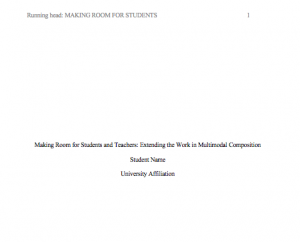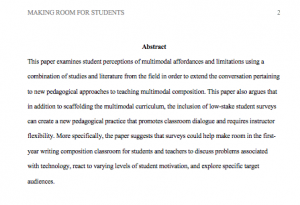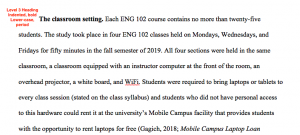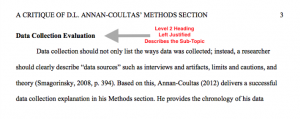Formatting Your Paper in APA
American Psychological Association (APA)
The American Psychological Association, established in 1892, is “the largest scientific and professional organization of psychologists in the United States” with approximately 117,000 members (“American Psychological Association”). The American Psychological Association created their style guide in 1929 and is most often used in the social sciences such as psychology, education, and linguistics. Scholars in English rarely use APA; however, scholars in the field of Composition and Rhetoric do. For more help with APA please visit the OWL of Purdue’s APA Guide.
Your paper should always use Times New Roman, 12 point font, and one-inch margins. The entire manuscript should also be double spaced.
Formatting the Title Page (page 1)
- Insert the “Running head: ABBREVIATED TITLE” and page # in the right hand corner on page one
- Tip: Choose “Different First Page” in Microsoft Word and Google Docs.
- Scroll down to the center of the page and center the following:
- Your Name
- Title of Your Paper
- Use title caps
- No quotation marks, italics, underline, etc.
- University Affiliation

Formatting the Abstract Page (page 2)
- Create a new page. This page should include the header (i.e. the abbreviated title of your work) without the words “Running head.”
- Center the word “Abstract” with no bold, underline, or quotation marks.
- Hit enter and do not indent. Write a short (150-250 words) summary of your paper.

Formatting the Beginning of Your Written Content (page 3)
- Create a new page. This page (and all those that follow) should also include the header without the words “Running head.”
- At the top of the new page, center and write the full title of your work. Do not use bold, underline or quotation marks. After the title, hit enter once, indent your paragraph ½ inch, and begin writing.
Levels 1-3 Headings
APA uses various levels of headings to distinguish sections in an essay. According to the OWL of Purdue, “[t]he levels are organized by levels of subordination, and each section of the paper should start with the highest level of heading.” The highest level of heading is 1 and the lowest is 5. However, in this section, only levels 1 through 3 are discussed.
Level 1 Heading
- Level 1 Heading (Centered, Bolded, Title Caps)
- Shows the section title (e.g. Literature Review, Methods, Results, Implications)
 Level 2 Heading
Level 2 Heading
- Level 2 Heading (Left-Justified, Bolded, Title Caps)
- Shows subsection titles (e.g. main ideas/topics)
Level 3 Heading
- Level 3 Heading (Indented, bold, lower-case, period)
- Shows subsections of subsections (e.g. sub-topics of topics)



